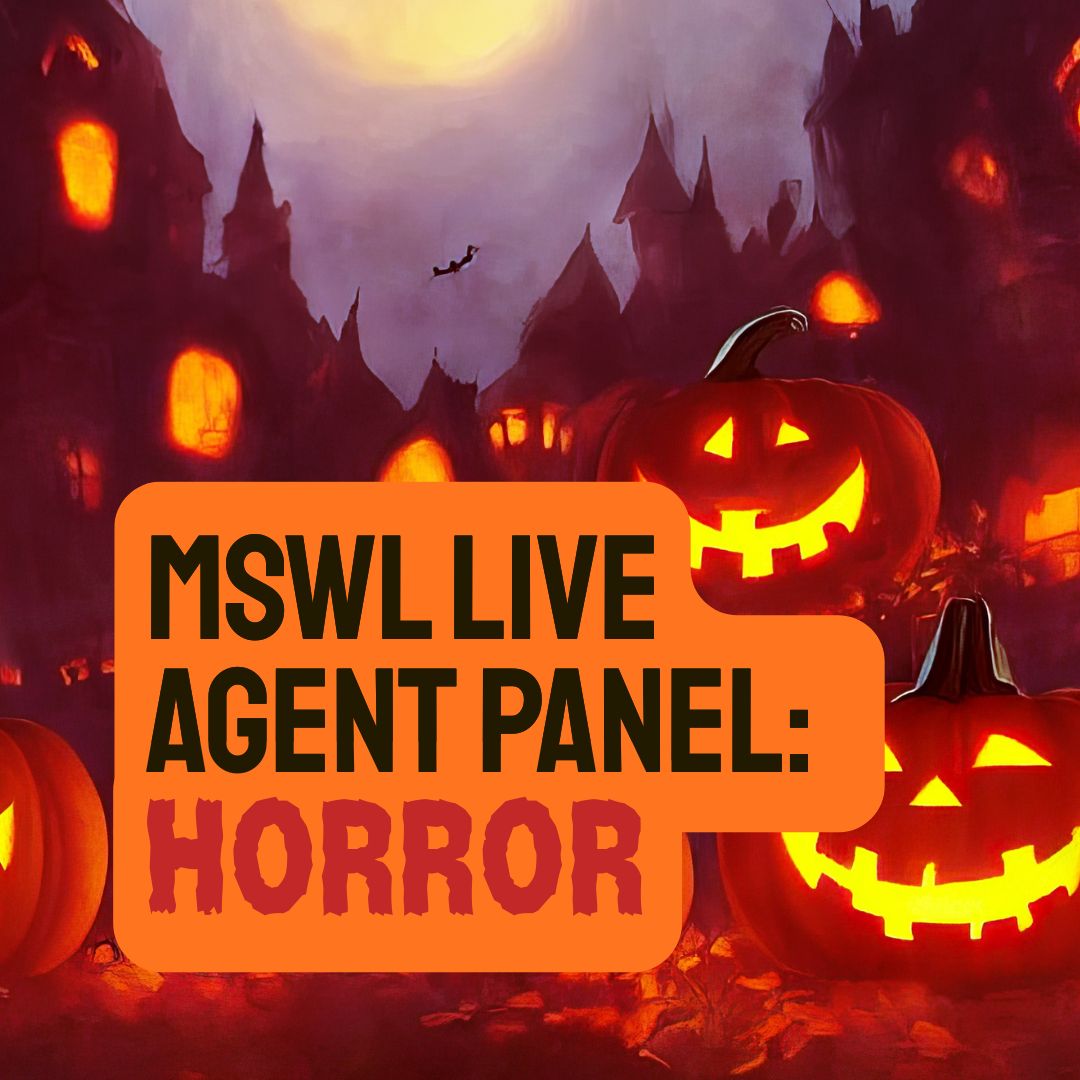
Use [CC] for Closed Captions | Click the magnifying glass over the paper for Transcript | Click the four outward arrows for full screen
“Horror is less a genre, more a mood – writing that evokes fear and/or disgust. If you can achieve that feeling, you’ve written successful horror.” – Tamara Kawar
“Character, character, character. Horror exploits fear. You must know what your character wants and WHY. If we don’t care, you’ll leave your audience cold.” – Linda Camacho
“By averting the reader’s eyes, you make them an active participant in the storytelling. Nothing is scarier than imagination.” – Erica Bauman
Live Event Timestamps
00:00 Welcome and Introduction
00:43 Meet the Panelists
01:32 Agent Linda Camacho’s Horror Wishlist
02:15 Agent Tamara Kawer’s Horror Wishlist
04:01 Agent Erica Bauman’s Horror Wishlist
05:29 What Makes a Good Horror Novel?
11:34 Mini Class: Withholding Details in Horror Writing
23:58 Query Critique with Tamara Kawer
34:48 Word Count Debate
35:18 Linda’s Horror Writing Class
37:24 Desire Lines in Horror
38:55 Exploring Pet Cemetery
42:21 Tension and Conflict in Horror
44:28 Sacrifice in Horror
49:25 Q&A: Horror Trends and Tips
58:23 Prizes and Closing Remarks
What Makes Great Horror In 2025/2026
Key Trends
- Social & Political Commentary: Horror as a vehicle for fighting back with words
- Resurgence in Publishing: 25% increase in US, 50%+ in UK
- Editors Are Responsive: Open to subversive, politically-charged content
- Deep Character Work: The advantage books have over film
Hot Sub-Genres
- Psychological horror
- Gothic horror
- Historical horror
- Contemporary horror with sociopolitical commentary
- Fairytale/horror mashups
- Monster romance
- Queer, trans, and feminist horror
Masterclass 1: Withholding Details with Erica Bauman
The Principle: What’s in the box? Weaponize your reader’s imagination.
Tools for Creating Horror
- Tension & Pacing – Build slowly, break strategically
- Heightened Emotions – Put readers in the character’s skin
- Vivid Description – Sensory details that linger
- Misdirection – Let imagination fill the gaps
Techniques for “Looking Away”
- Scene/Chapter Breaks – Cut at the moment of horror
- Time Skips – Jump to aftermath, let readers infer
- Brevity – Less description = more impact
- Close Eyes (first person) – Character literally averts gaze
- Focus on Reaction – Show horror through character response
Famous Examples
- Rosemary’s Baby (1968): Never shows the baby, only Mia Farrow’s reaction
- The Hitcher (1986): Cuts to black at moment of death
- Se7en (1995): “What’s in the box?” – we never see it, but our brains fill in the blank
Key Takeaway: By averting the reader’s eyes and alluding to horror, you make them an active participant. Nothing is scarier than imagination.
Masterclass 2: Character & Desire Lines with Linda Camacho
Core Principle: When stuck on plot, look to character. You cannot separate plot and character.
The Three Desire Lines
1. External Desire
- What character wants to physically accomplish/gain
- Must be specific
- Can evolve, but must align with internal desire
2. Internal Desire (The “Why”)
- Character’s underlying fear or motivation
- Critical Question: Why is this situation particularly difficult for THIS specific character?
- Specificity makes readers care
3. Desire + Intention = Tension
Formula: Character’s Want + Obstacle = Tension
The monster/environment must run counter to the character’s desire line
Case Studies
Pet Sematary
- External: Doctor wants to provide for family in new town
- Internal: Cannot accept death, loss of family
- Why It Works: Both parents refuse to discuss death (trauma-based), making the story particularly tragic for them
The Shining
- External: Jack wants fresh start, career success
- Internal: Overcome father’s legacy, feelings of inadequacy, alcoholism
- Why It Works: The Overlook Hotel exploits his specific insecurities
Arachnophobia
- External: New doctor wants to establish practice
- Internal: Paralyzing fear of spiders from childhood
- Sacrifice: Must literally face spiders in his basement to save family
- Perfect Bookend: Paralyzed as baby with spider = paralyzed in basement with spider
Desire and Sacrifice
Good horror requires surrendering to fear. Character must “run back into the burning building” – face what terrifies them most because something bigger is at stake.
Remember: If a character doesn’t surrender in the climactic scene, there’s no real showdown.
Query Letter Masterclass with Tamara Kawar
Strong Query Elements
- Tone-Setting Opening – Match your query’s mood to your book’s mood
- Clear Stakes – What will be lost if protagonist fails?
- Character Baseline – Show us their starting point
- Turning Point – What disrupts the status quo?
- Beautiful, Horrifying Language – “forest that lies stitched over hours like a second skin”
Common Improvements
- Specs: Always include age category (adult/YA/MG)
- Comp Freshness: Aim for 2-3 years old, not 5
- Comp Reasoning: Explain WHY these are your comps (the X of Title A meets the Y of Title B)
- Streamline Summary: Combine related information, avoid repeating the “things get real” moment
- Word Count: ~330 words for summary, leaving room for bio
- Always Include Bio: Even with query managers, put it in the letter itself
Ending Strong
Leave agents wanting more by showing:
- What’s at stake for characters
- The looming threat
- Why readers will care about the outcome
Agent Q&A Highlights
On Vampires
Status: BACK IN! Enough time has passed, and fresh takes are emerging. Think: Sinners, Interview with the Vampire series.
On Comp Age
Not an automatic fail, but balance older comps with recent book comps to show you’re reading in the genre currently.
On Genre Mashups
Good news: Editors are finally open to horror/thriller, horror/fantasy blends. Use what feels natural for your story.
On Trigger Warnings
- Be overcautious – everyone’s tolerance differs
- Include in query letter for major triggers
- Also use query tracker fields when available
- “Why not both?”
On Pacing
Slow burn is fine – as long as tension varies. Not everything needs to be Michael Bay explosions. Master the craft of sustained dread.
On POV/Tense
No preference – Use what sounds most natural for your story and fits your vision.
#MSWL Specifics
Linda Camacho Seeks
- Horror across all age ranges (picture book through adult)
- Stories that use horror as comfort and exploration
- Deep, character-driven scares
Tamara Kawar Seeks
- Queer, trans, and feminist horror
- Ghost stories with sociopolitical commentary
- Historical horror (comp: Buffalo Hunter)
- Fairytale horror mashups (comp: Butcher of the Forest)
- Monster romance (comp: The Monster of Elendhaven)
Erica Bauman Seeks
- “Auteur horror” – surprising depths
- Gothic, rural, psychological, and social horror
- Horror with the sensibility of A24 films
- Middle grade and up, light genre on adult side
